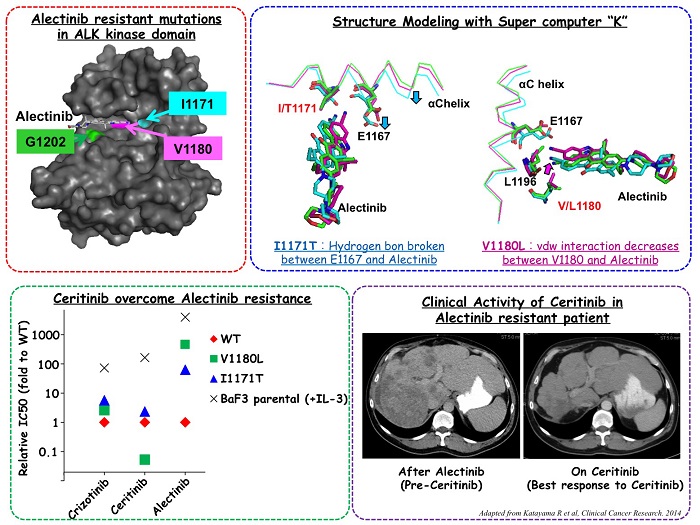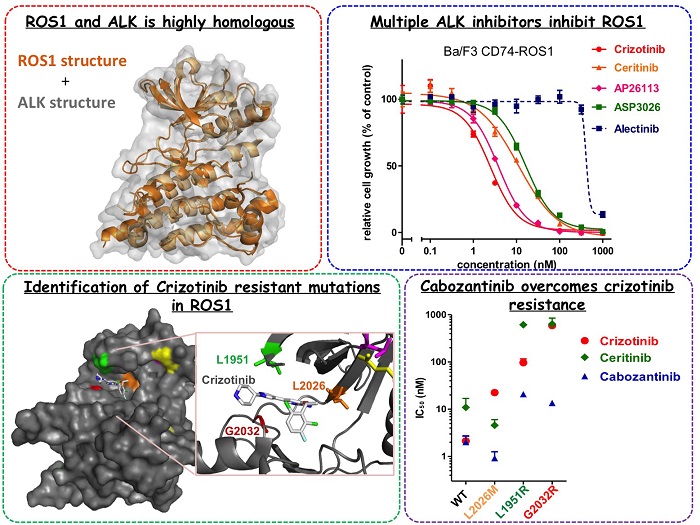- HOME
- Outstanding Progress
Identification of the resistance mechanisms to ALK or ROS1 inhibitors, and inhibitors which can overcomes the resistance.
- We have identified two novel ALK mutations (V1180L and I1171T) arising after alectinib exposure that are sensitive to other next-generation ALK inhibitors (Ceritinib and AP26113).
- We developed a comprehensive model of acquired resistance to ROS1 inhibitors in NSCLC with ROS1 rearrangement and identified cabozantinib as a therapeutic strategy to overcome the resistance.
Paper1:
Two novel ALK mutations mediate acquired resistance to the next generation ALK inhibitor alectinib
Clinical Cancer Research
Ryohei Katayama1, Luc Friboulet5, Sumie Koike1, Elizabeth L. Lockerman5, Tahsin M. Khan5, Justin F. Gainor5, A. John Iafrate5, Kengo Takeuchi2, Makoto Taiji3, Yasushi Okuno4, Naoya Fujita1*, Jeffrey A. Engelman5*, Alice T. Shaw5*
* Corresponding Authors (Naoya Fujita, Jeffrey A. Engelman、Alice T. Shaw)
○Affiliation
- Cancer Chemotherapy Center, Japanese Foundation for Cancer Research
- Pathology Project for Molecular Targets, the Cancer Institute, Japanese Foundation for Cancer Research
- Processor Research Team, RIKEN Advanced Institute of Computational Sciences
- Graduate School of Medicine, Kyoto University
- Massachusetts General Hospital Cancer Center
Paper2:
Cabozantinib overcomes crizotinib resistance in ROS1 fusion positive cancer
Clinical Cancer Research
Ryohei Katayama1, Yuka Kobayashi1, Luc Friboulet2, Elizabeth L. Lockerman2, Sumie Koike1, Alice T. Shaw2, Jeffrey A. Engelman2, and Naoya Fujita1*
* Corresponding Authors (Naoya Fujita)
○Affiliation
- Cancer Chemotherapy Center, Japanese Foundation for Cancer Research
- Massachusetts General Hospital Cancer Center
Abstract of Paper 1:
The ALK tyrosine kinase inhibitor (TKI) crizotinib is a standard therapy for patients with ALK-rearranged NSCLC. However, cancers invariably develop resistance to crizotinib and this has spurred the clinical development of multiple next-generation ALK-TKIs, including alectinib (RO5424802/CH5424802) and ceritinib (LDK378). To determine how cancers develop resistance to alectinib, we established a cell line model of acquired resistance to alectinib and analyzed a resistant tumor specimen from a patient who had relapsed on alectinib. We identified two novel secondary ALK mutations, both of which were still sensitive to ceritinib in vitro. Importantly, we found that in the patient, ceritinib was able to overcome resistance to alectinib, suggesting a potential role for sequential therapy with multiple next generation ALK TKIs.

Abstract of Paper 2:
ROS1 gene rearrangement leads to constitutive ROS1 activation with potent transforming activity. Although crizotinib shows remarkable initial responses, cancers eventually develop resistance to crizotinib. To identify further mechanisms of resistance to crizotinib, we performed ENU mutagenesis screening using CD74-ROS1-expressing Ba/F3 cells, and identified several novel crizotinib resistance mutations in the ROS1 kinase domain including the G2032R mutation, which is observed in the crizotinib resistant patient. To overcome the identified crizotinib resistance, we performed high throughput drug screening, and found that the cMET/RET/VEGFR inhibitor cabozantinib (XL184) effectively inhibited the survival of both WT and crizotinib resistant mutated CD74-ROS1-expressing Ba/F3cells. Since cabozantinib (XL184) is clinically available for the treatment of thyroid cancer patient, the finding that cabozantinib can overcome the crizotinib resistances caused by secondary mutations in ROS1, potentially could change the therapeutic strategies for ROS1 rearranged NSCLC.






